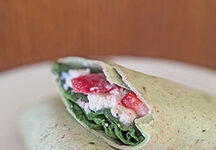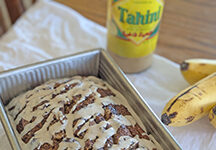Amanda Miller
Columnist
Lettuce Eat Local
Like in any marriage, when Brian and I got married, I knew some of the things I was “marrying into.” Perhaps the most obvious, besides the presence of in-laws, was the family dairy farm — it’s hard to hide 350 cows. Brian is the youngest of the kids but the only one who wants to farm, so that was a given for our relationship and future.
Of course family traditions and ways of doing and approaching things also come with that territory, and in my case, the physical territory did too as I moved to Kansas from Ohio. A lot of things from the conjunction of family and community are now part of my life, thanks to Brian’s bringing me into his life here. Some were expected and some are not, some are more appreciated and some are not, some are obvious and some are not.
This past weekend at the Kansas Mennonite Relief Sale I was reminded of one of the more unique foodways I’ve acquired: I married into verenike. Those of you who know what I mean, you know what I mean. For those of you who are unintroduced like I was pre-Miller, verenike (pronounced va-ren-i-ka) is a dry-cottage-cheese filled ravioli/pierogi/dumpling very traditional to Russian Mennonites. Or Ukrainian, or German, it’s hard to get concrete information on verenike, or varenika, or varenyky, etc.
I think partly the reason their origin is so nebulous is because they’ve been passed along through the generations exactly like how they are for my family. Everyone who knows verenike either grew up with them, or married into them, but rarely are they left behind.
This is just my take, but they’re probably also rarely picked up by anyone who has no prior connection to them. I mean, they’re fine and all, but I eat them for the accompanying ham gravy. (And if you’re bristling at my callousness, then I’m guessing you have memories of verenike from your childhood.) Don’t get me wrong, I make them sometimes, but they are a lot of work, so I’m either feeling very loving towards Brian or know it’s for the kind of people whose eyes light up when you mention them.
Actually, that’s not entirely fair. I also like making them for people who have no idea what they are, because even though I married into them and don’t necessarily enjoy them myself, they are one of the beautiful ways to share and pass on cultural treasures. I want my children to grow up with fond memories of them, just like their daddy.
And fortunately, if I don’t feel like making verenike, I know there’s an annual chance for my kids to make memories of them anyway — the Kansas Mennonite Relief Sale, held every year on the Kansas State Fairgrounds in mid-April. I wish I could take a poll of how many of the thousands of attendees would identify verenike and ham gravy as The Reason to come, but judging by the lines out the door, it would rate significantly. For many people, this is the one time a year they eat verenike, and it is certainly a staple of the weekend…and therefore of their culture, whether they grew up with it, married into it, or maybe even just discovered it.
And that I love. Especially if it comes with an extra ladle of ham gravy.
Creamy Ham Gravy
I know, I know, the whole article was about verenike, but did you notice how I stressed how time-consuming they are to make? The filling, dry cottage cheese, is only available in a very few select locations, which is why I make mine, but that only adds another layer of effort necessary for their creation. I am Mennonite both by choice and heritage, but not a verenike Mennonite, so I have no qualms telling you to just go find some cheese tortellini (I’ve never tried this but they seem like they could be baby verenike) or bake up some biscuits, just some vehicle by which to enjoy your ham gravy. OR go to the KMRS next April, or Carolyn’s Essenhaus in Arlington, KS on the first Friday of the month.
Prep tips: This recipe is very basic, so make sure to use decent ham; and season well, in accordance with whatever you’re serving it on.
2 cups diced ham
6 tablespoons butter
¾ cup flour
1 teaspoon each salt and pepper, plus more as desired
4 cups whole milk/cream
Sauté ham in butter until nicely browned on the edges; stir in flour and seasonings. Add milk gradually, whisking well, and cook until thick and smooth.





